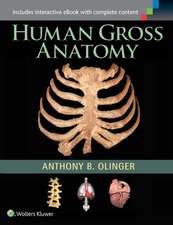Atlas of Functional Shoulder Anatomy
Editat de Giovanni Di Giacomo, Nicole Pouliart, Alberto Costantini, Andrea de Vitaen Limba Engleză Hardback – 16 iul 2008
Difficulties of technical nature, which today have been overcome thanks to technology, delayed the use of endoscopy in shoulder treatment thus filling the gap previously existing if compared with other joints surgery (i.e., knee). Shoulder arthroscopy, exploiting anatomical integrity, has contributed with excellent results to the identification of those structures that have been given little descriptive importance in classical texts.
The purpose of this Atlas is to focus the reader’s attention on a series of bone, ligament, muscle and tendon structures and ultrastructures on which only the most recent international literature has reported in specialized journals. This Atlas also presents extremely high-definition images of "targeted" sections obtained from cadavers preserved using state-of-art techniques.
This unique Atlas, making use of images of major visual impact, offers a scientific message on a topical joint, using simple but dedicated descriptive language.
Among the various aims of this volume, the authors intend to present the shoulder anatomy in a new and original way and want to help the reader to understand the complexity of scientific research, highlightening the importance of the integration of anatomical, biomechanical, and neurophysiological knowledge.
The text is intended to complete the most recent and current anatomical studies of scientific research, enhancing those minimal structures to which a precise and clear mechanical andneurological role is now being attributed.
Preț: 2247.99 lei
Preț vechi: 2366.30 lei
-5% Nou
Puncte Express: 3372
Preț estimativ în valută:
430.29€ • 467.55$ • 361.68£
430.29€ • 467.55$ • 361.68£
Carte tipărită la comandă
Livrare economică 18-24 aprilie
Preluare comenzi: 021 569.72.76
Specificații
ISBN-13: 9788847007581
ISBN-10: 8847007585
Pagini: 240
Ilustrații: XVI, 231 p.
Dimensiuni: 279 x 210 x 19 mm
Greutate: 1.29 kg
Ediția:2008
Editura: Springer
Colecția Springer
Locul publicării:Milano, Italy
ISBN-10: 8847007585
Pagini: 240
Ilustrații: XVI, 231 p.
Dimensiuni: 279 x 210 x 19 mm
Greutate: 1.29 kg
Ediția:2008
Editura: Springer
Colecția Springer
Locul publicării:Milano, Italy
Public țintă
Professional/practitionerCuprins
Part 1 Scapulothoracic joint: Muscles for scapulothoracic control: role of the scapula. Latissimus dorsi muscle. Pectoralis major muscle.- Part 2 Acromioclavicular joint and scapular ligaments: Introduction. Scapular ligaments.- Part 3 Glenohumeral joint (muscle-tendon): Deltoid muscle. Rotator cuff. The long head of the biceps.- Part 4 Glenohumeral capsule: Fibrotendinous cuff of the capsule. Superior (glenohumeral ligament) complex. Anterior and inferior glenohumeral capsuloligamentous complex.- Part 5 Neuromuscular control and proprioception of the shoulder: Introduction. Mechanoreceptors of the shoulder joint: structure and function. The role of 'proprioception' in shoulder disease.
Textul de pe ultima copertă
The purpose of this Atlas is to focus the reader's attention on a series of bone, ligament, muscle and tendon structures and ultrastructures that have not so far been discussed except in the most recent international literature and in specialist journals. This Atlas also presents extremely high-definition images of "targeted" sections obtained from cadavers preserved using state-of-the-art techniques.
The authors' intention is to present the shoulder anatomy in a new and original way and, using a simple but dedicated descriptive language, to help the reader understand the complexity of scientific research, highlighting the importance of integrating anatomical, biomechanical and neurophysiological knowledge.
The text is intended as a complement to the most recent and current anatomical studies in scientific research, bringing out the importance of those miniscule structures to which precise and clear mechanical and neurological roles are now being attributed.
The authors' intention is to present the shoulder anatomy in a new and original way and, using a simple but dedicated descriptive language, to help the reader understand the complexity of scientific research, highlighting the importance of integrating anatomical, biomechanical and neurophysiological knowledge.
The text is intended as a complement to the most recent and current anatomical studies in scientific research, bringing out the importance of those miniscule structures to which precise and clear mechanical and neurological roles are now being attributed.
Caracteristici
Focuses the reader’s attention the fine anatomical structures within the shoulder on which only the most recent international literature has reported in specialized journals. Presents high-definition images of "targeted" sections obtained from cadavers preserved using state-of-art techniques. Uses simple but dedicated descriptive language.














